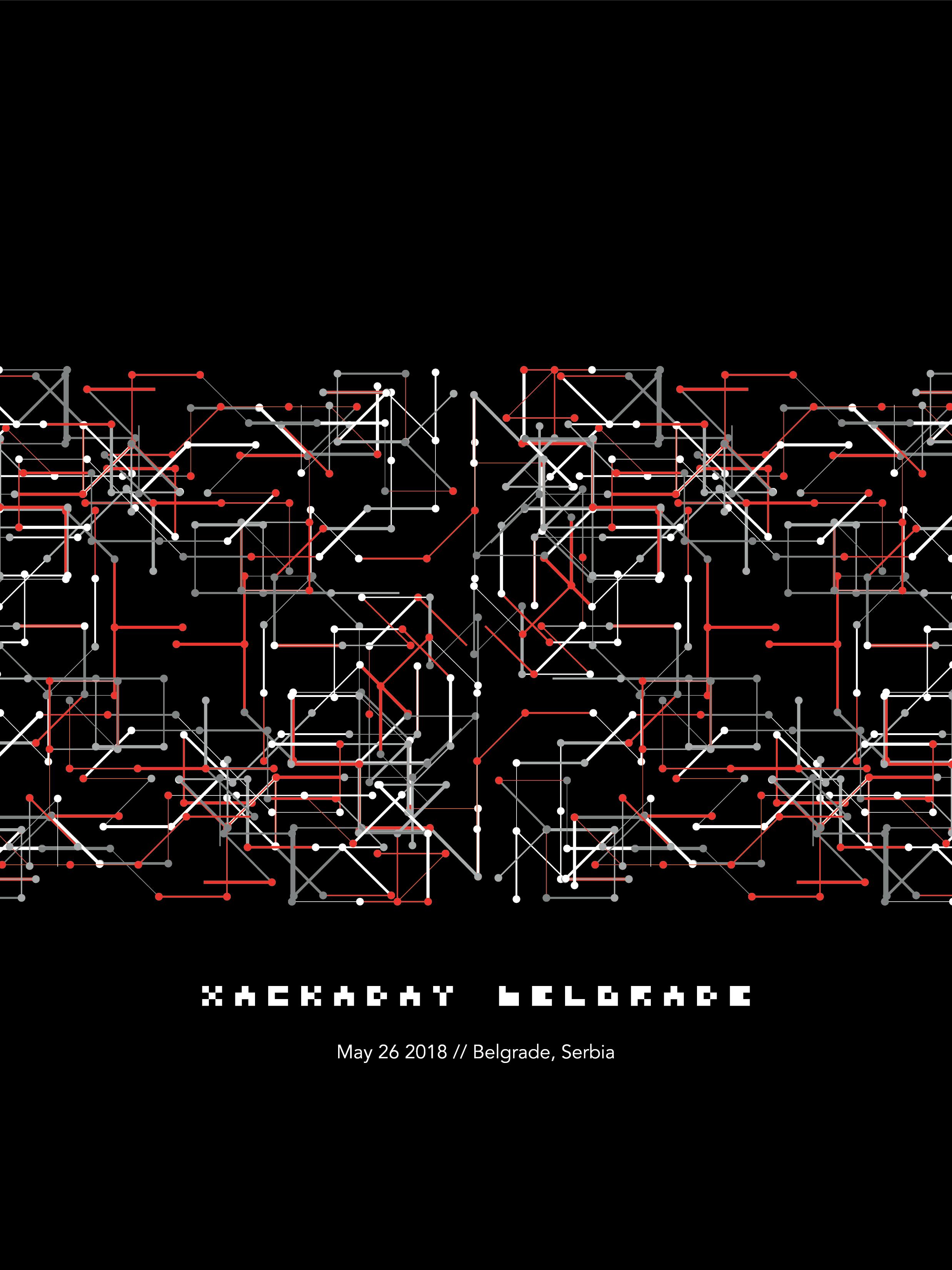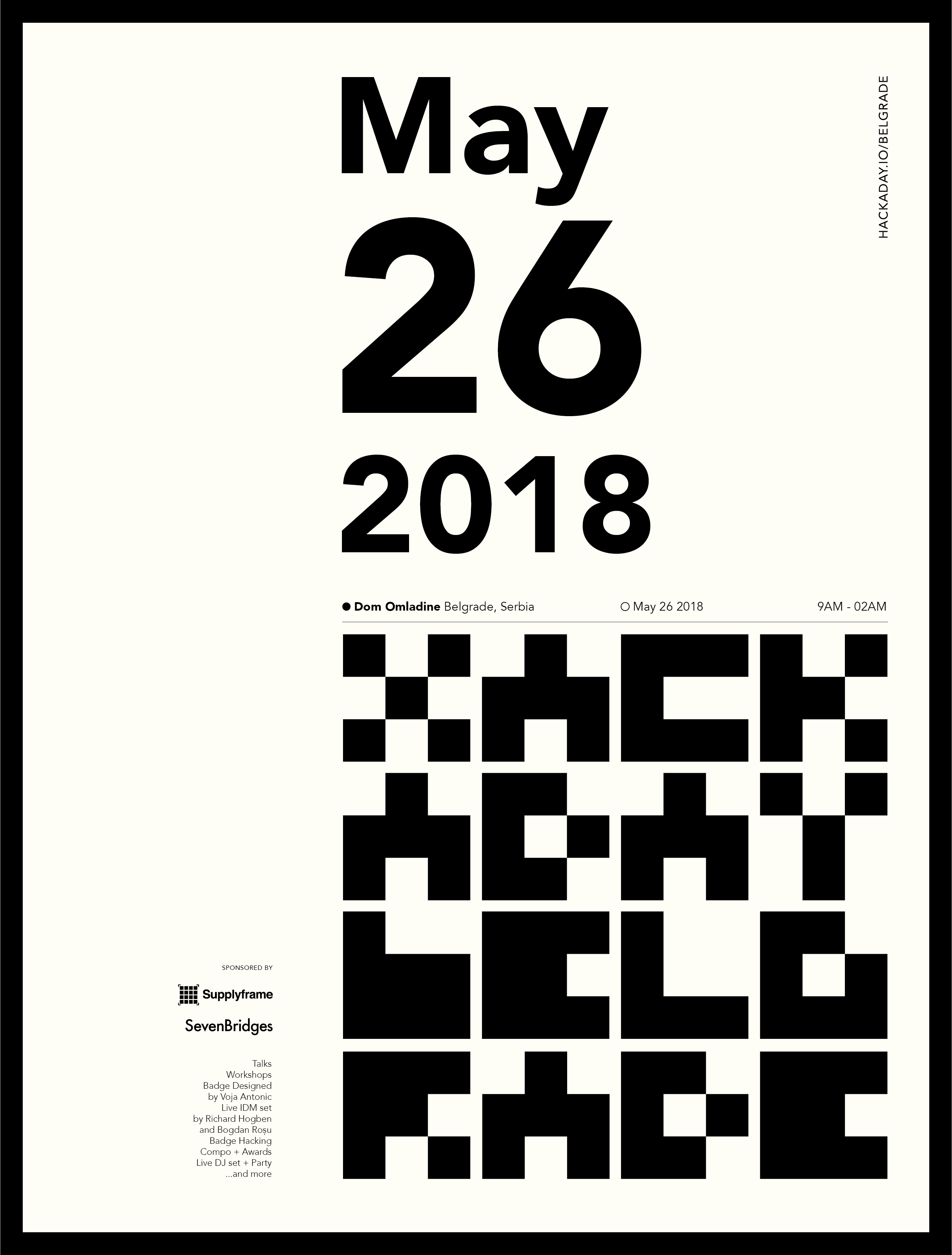 Sell tickets and manage registrations
Sell tickets and manage registrations
 View my tickets and registrations
View my tickets and registrations
 Sell more tickets through digital marketing
Sell more tickets through digital marketing
 Add an event calendar to your website
Add an event calendar to your website
 Find events by location and categories
Find events by location and categories
Hackaday | Belgrade 2018

We are incredibly excited to announce the return of Hackaday Belgrade, a one day conference on Saturday, May 26th in Belgrade, Serbia.
You will experience talks and workshops exploring the most interesting uses of technology and the culture that goes along with it. This includes design, prototyping, research, manufacturing, and the stories of people and progress that move hardware hacking forward. Demos, badge hacking, food and drink, DJ sets, and a warm and welcoming village of great people make this an event you don't want to miss.
This will sell out, get your ticket now!
Conference Events:
We hosted Hackaday Belgrade for the first time in 2016 to an enthusiastic, sold-out hall. We are very excited to be doing it again, here's what we have in the works:
Talks and Workshops will cover hardware, engineering, creativity in technical design, product design, prototyping, etc. run from 10am until 7pm. A complete schedule of events was announced at the end of April and can be found below.
Badge Hacking goes all day and will be extended into the wee hours of the morning. Every attendee of Hackaday Belgrade will receive one of these
A Party with Two Stages will spin up with live IDM performances by
There's More:
We're keeping the costs low to offset your travel costs. Belgrade is gorgeous in May, and getting there from other parts of Europe is very affordable. The cost of the admission includes the cost of the badge, as well as excellent food and drink during the conference and a party late into the night.
Many of the Hackaday crew will be on hand and we’re likely to have a less-formal meetup on Friday evening. Check out the
Belgrade will be the hardware center of the Universe this May. See you in Belgrade!
URL:
LOCATION: Dom omladine Beograda, Makedonska 22 // Belgrade // Serbia // Europe
SPONSORS:
COMPLETE SCHEDULE BELOW:
Keynote: Jack of All Trades, Master of One
Rachel Wong Session 1
Rachel Wong has two passions. In her spare time she designs and builds wearable electronics with an eye to a time when high-tech fashion will be commonplace. When at work she is a stem cell researcher, focusing on projects like growing human eyes. The resulting tissue can be used to give the blind sight, and is now in clinical trials. Success in this line of research will help pave the way for breakthroughs in the development of other organ tissue. Rachel will discuss her work in both wearables and stem cell technology, taking the audience along for a glimpse into the future.
Building the Hackaday Belgrade Badge
Voja Antonic and Jaromir Sukuba Session 2
The custom electronic badge for the Hackaday Belgrade Conference was conceived, designed, and manufactured specifically for this event. Join Voja Antonic, who designed the hardware, and Jaromir Sukuba, who designed the firmware, as they discuss the process of producing unique electronics on tight timelines.
5 Cases of Designing for Meaningful Hardware
Vanessa Julia Carpenter Session 3
Five cases of hardware prototypes developed to explore what makes a meaningful experience are presented. From unusual sensors in jewellery, capacitive touch in Japanese craft, and a Bluetooth speaker / music creation interface, Vanessa extracts the qualities from each that move us towards creating experiences which help us to build identity and connect to ourselves and others. Vanessa asks engineers, hackers, makers, and inventors how can we create smart products with a focus on value over function?
Designing PCBs with Code
Kaspar Emanuel Session 2
Most engineers use EDA software to design circuits, but there are other ways. Kaspar has been exploring various tools and languages that allow you to use code rather than CAD software for your circuit design. If you have ever thought “I could easily solve this with a for-loop” when using KiCad or Eagle then this talk is for you. The overview and history speaks to programmers thinking about getting into designing circuits, anyone used to expressing their ideas with code, and those who enjoy learning different approaches to unique problems.
Bitbanging is so 2017 (Fast Peripheral Control from Raspberry Pi and Friends)
Matt Evans Session 2
There is a simple technique to output high-speed signals from a Raspberry Pi, with zero CPU overhead, in a slightly unexpected way. By re-purposing the Display Parallel Interface (DPI) video hardware, arbitrary control signals are output by writing patterns to the framebuffer. This is faster and lower-overhead than ‘bit banging’ IO ports in software. Matt will cover the concepts, give an example (and possibly demo) of driving a 64×64 RGB LED array, and discuss other potential uses.
Blimps — Like a Drone But Won’t Take Your Head Off
Sophi Kravitz Session 1
A blimp is a nonrigid airship used for advertising, scientific research… and fun! Sophi developed a mini-blimp to fly around the house, through hula-hoops, and to go to death battle with other mini-blimps. This mini-blimp features custom hardware bringing together motor controls, a power system, and an ESP8266 which talks to a giant red joystick. Since a mini-blimp is essentially some tiny fan motors propelling an oddly shaped balloon, it seemed like this would be an easy task. While developing her own mini-blimp, Sophi learned that making something that flies has a bunch of gotchas which she’ll detail during her presentation.
Build your Acoustic Levitator at Home
Asier Marzo Session 1
Acoustic Levitation uses the energy of sound to hold particles in mid-air without any physical contact. Acoustic levitation is not suited for supporting large mass like humans but, quite useful for manipulating small particles including liquids and powders. Levitated droplets of reagents are already being used in lab work during complex chemical reaction. Asier Marzo plans a live demonstrations to go along with this talk covering how to build an acoustic levitator with regular off-the-shelf components.
Drone Assisted IoT Sensor Network Deployment and LoraWAN Coverage Mapping
Luka Mustafa Session 1
Studying wildlife in remote areas to implement informed conservation strategies requires a simple and time-efficient method to build sensor networks covering vast inaccessible areas. As founder of the Institue IRNAS, Luka has developed animal trackers, static sensors, and drone automated signal coverage mapping methods across water and over tree-tops. In his talk he will present solutions and challenges encountered in projects involving Green Sea Turtles monitoring in Africa, and Arboreal monitoring in Peru.
State of the Hackaday
Mike Szczys Session 3
Hackaday Editor in Chief Mike Szczys takes the stage to discuss the past, present, and future of this amazing community. From Hackaday’s editorial voice to its celebration of new tricks and techniques, from weekly Hack Chats to monthly meetups, and from a global engineering initiative to a scholarly journal, Hackaday holds high the pursuit of knowledge and the free and open sharing of information and ideas. Mike looks at the common threads that bring us all together and make Hackaday the greatest engineering community on earth.
Hacking Soldering Robot with Open Source Hardware Laptop TERES-I
Tsvetan Usunov Session 3
What happens when industrial automation robots come with terrible UI and programming? Tsvetan takes on the challenge of improving a robot used for soldering plated through-hole (PTH) components. Improvement efforts included more sophisticated software, adding cameras to provide feedback, and hacking the communications protocol. Tsvetan will show just how good this automated soldering machine can become with the right alterations.
Building a TTL Microcomputer Without a Microprocessor
Marcel van Kervinck Session 2
Marcel designed and built a small 8-bits homebrew computer using a few dozen 1970s TTL chips, an oscillator, some RAM, an EPROM, and a handful of passives. The computer has similar capabilities as the microcomputers of the early 1980s and the first PCs, except that it has no brain; it is entirely driven by simple TTL logic, without the need for a microprocessor, a video card, or a sound chip. Marcel shares his experience including what went right and what went wrong along the way.
Logic Noise: Hacking Music out of Digital Chaos
Elliot Williams Session 2
Of course you could just take a beautiful-sounding instrument and simply play the right notes. But that’s taking the easy way out. Instead, this talk is about using basic logic ICs to build something musical or at least interestingly noisy, a tradition that’s as old as the 4000-series chips themselves. Elliot will demo a big handful of his favorite algorithms and circuits for composing in solder, and if all goes well, “music” will emerge.
The Earliest Computer-Controlled Interactive Robotic Sculptures
Aleksandar Zivanovic Session 3
Aleksandar explores some of the earliest truly interactive robotic sculptures, developed by Edward Ihnatowicz. His first sculpture, Sound Activated Mobile, used analogue electronics to turn to face the direction of sound and was exhibited at the Cybernetic Serendipity exhibition in 1968. His largest work, The Senster, was a hydraulically actuated, computer-controlled robot that turned to face visitors to the Evoluon in the Netherlands in 1970. Join in on a journey to the dawn of robotics as art.
COMPLETE WORKSHOP DETAILS:
Creating Art in PCB
Brian Benchoff Session 1
This workshop will guide attendees through the process of creating art in PCBs. Topics covered will be the layer stackup of the modern PCB (copper, fiberglass, soldermask, and silkscreen), the current state-of-the-art using Chinese board houses, and how to implement graphics in PCB art using KiCad.
Interactive Poetic Glove
Lavoslava Benčić Session 2
In this e-textile workshop, participants will create a unique interactive wearable that generates sounds of various frequencies and responds to the touch (pressure). This includes learning about electronic elements and circuits with emphasis on the capacitive, conductive, and resistive properties of fabrics and yarns.
FPGA Development 101
Miodrag Milanovic Session 3
This workshop will show the capabilities of FPGA devices, providing an introduction into FPGA tools used and the Verilog hardware description language. We will go through prepared examples and show the differences in approach when doing design for FPGA and MCU.


